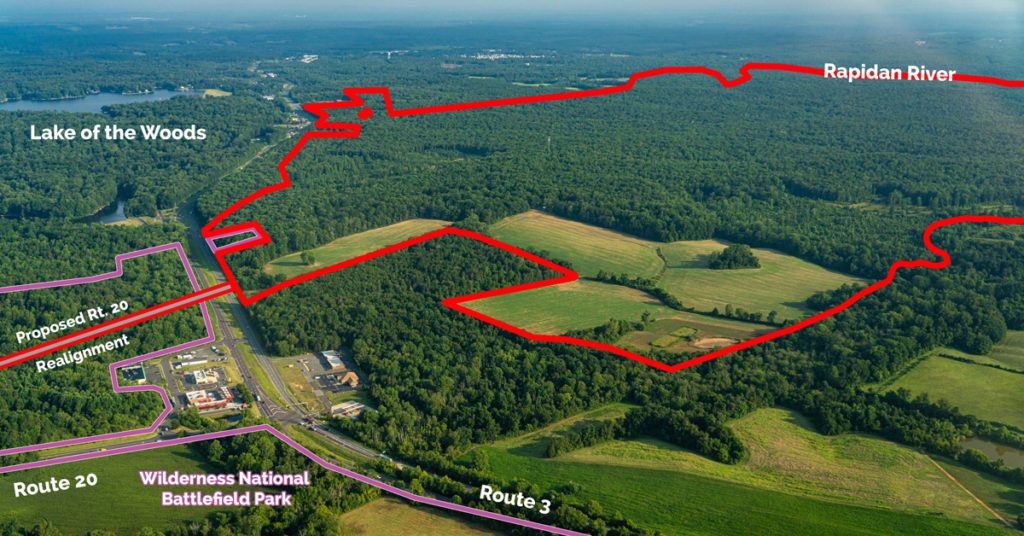A look at how PEC works on behalf of our nine counties
When it comes to policies and decisions that impact communities and quality of life for their residents, the most important voices are those of community residents themselves. And since 1972, The Piedmont Environmental Council has worked hard to be your eyes and ears on the ground and to encourage your voice in protecting the places and natural resources you care about.
When a development proposal crosses the desks of county planners and elected officials, like the massive Wilderness Crossing proposal in Orange County, our field staff review them closely, looking to see how these proposals might affect drinking water, traffic, taxes, natural, historic, and cultural resources, and more, sharing our findings with you, and helping you share your input with county leaders.

Wilderness Crossing is a 2,602-acre rezoning proposal bordered by Rt. 3, Spotsylvania County, and two miles of the Rapidan River. The majority of the site is currently zoned agricultural, with some zoning for commercial, industrial, and up to about 1,114 residential units. The developer requests the entire property be rezoned to Planned Development-Mixed Use (PDM), allowing a mix of commercial, office, light industrial development, open space, and six to 12 residential units per acre—which translates to 7,807 to 20,299 residential units. Based on Orange’s average of 2.36 people per household, those units could support up to 47,906 people. For comparison, in 2019, Orange County had 15,382 residential units and a population of 36,254.
If approved, Wilderness Crossing would be the largest rezoning in county history. “When reviewing proposals like this, we’re looking for what is and isn’t written in black and white: the possible outcomes and unintended consequences that developers sometimes obscure with pretty pictures and unenforceable promises. Wilderness Crossing is a great example,” said Chris Hawk, PEC’s Orange County field representative.
Public health risks from mercury contamination
During Virginia’s gold mining era (1804 to 1937), the Wilderness Crossing property was the site of at least 27 large-scale mining operations, including 18 pit mines and nine shaft mines. In Virginia, gold was extracted using mercury, considered by the World Health Organization to be one of the top 10 chemicals of major public health concern. Virginia’s Department of Environmental Quality and the Environmental Protection Agency have deemed the adjacent 2.2-mile section of the Rapidan River impaired due to mercury in fish tissue and have prohibited the consumption of fish from this section of the Rapidan.
The Wilderness Crossing application makes no mention of mercury contamination from past gold mining activities and offers no environmental study to ensure residents that the disruption of soil for the grading and construction of thousands of homes won’t further contaminate drinking water or the environment where thousands of people may live and work.
Disruption to historic and natural resources
We also look at development proposals for potential threats to historic and cultural resources, national parks and public recreational spaces. Wilderness Crossing would sit about a quarter-mile northeast of the existing Rt. 3/Rt. 20 intersection. The developer proposes rerouting Rt. 20 so that it intersects with Rt. 3 at the planned entrance to Wilderness Crossing. This change in alignment would cost taxpayers and cause significant disturbance to hallowed ground, all so the developers can “direct traffic” to their development.
Unexpected burdens for taxpayers
Most development proposals include hard numbers of planned residential and commercial structures and a phased construction timeline, which are used to calculate likely needs for schools, roads, sewer, etc. The Wilderness Crossing proposal includes neither, and its developers have said they want market forces to determine the buildout. The developer’s fiscal and traffic impact analyses are based on arbitrary numbers of residential and commercial units within arbitrary timeframes, none of which are expressly requested in the application. “Given its size and location within Orange’s growth area, the details are incredibly important. Without them, Orange County can neither anticipate infrastructure needs nor realistically calculate the fiscal impacts of this development on county taxpayers,” Hawk said.
Bait-and-Switch potential
“When a developer asks for open-ended zoning and submits a proposal with few specifics, as this one has, it’s often a sign they are attempting to increase the value of the land with no real intention of building that project,” Hawk said. In the world of land use planning, this is often called speculative development. Based on potential outcomes for taxpayers, we call it bait-and-switch build-out. It works like this:
The Bait: A developer buys land with limited zoning at a low cost and then gets it rezoned with more development rights, often presenting pretty pictures and touting various benefits to the community, such as revenue or land for schools or parks. (This developer bought this land 30 years ago and this is their third attempt at rezoning.)
The Switch: Sometime after rezoning is approved, the developer sells the now-more valuable land at a profit, usually without even breaking ground. The new owner can then use the new zoning to build something completely different (and often worse) than the community thought it was getting.
Orange County today, your county tomorrow
While Hawk is reviewing the Wilderness Crossing proposal in Orange, analyzing potential outcomes and asking tough questions, PEC’s other field representatives are doing the same in other counties as well. This is what we have done for the past 50 years… educate, engage, and empower residents of Virginia Piedmont communities to advocate for good local outcomes. If you live in Orange, we hope you’ll join us in holding county supervisors accountable for doing what’s in the best interest of the county. And whether you live in Orange or elsewhere, we hope you’ll lean on us for all of your land use questions.
Learn more about Wilderness Crossing: https://www.pecva.org/region/orange/massive-rezoning-proposed-in-orange-county/
This story appeared in The Piedmont Environmental Council’s member newsletter, The Piedmont View. If you’d like to become a PEC member or renew your membership, please visit pecva.org/join.
